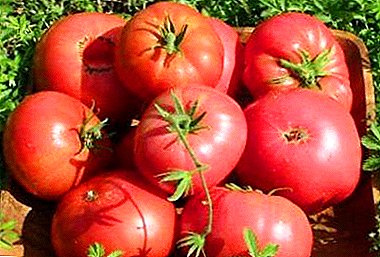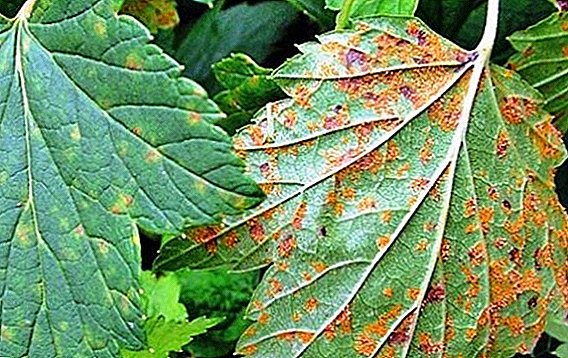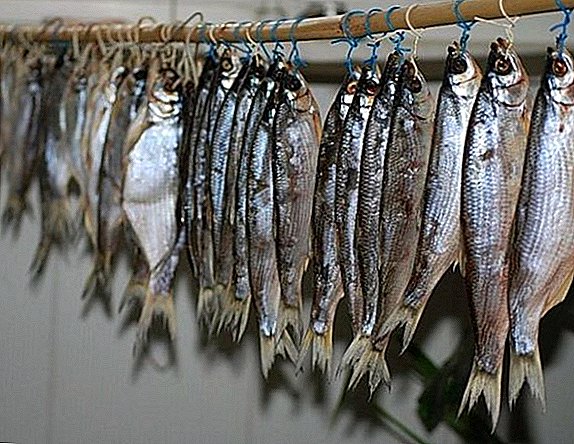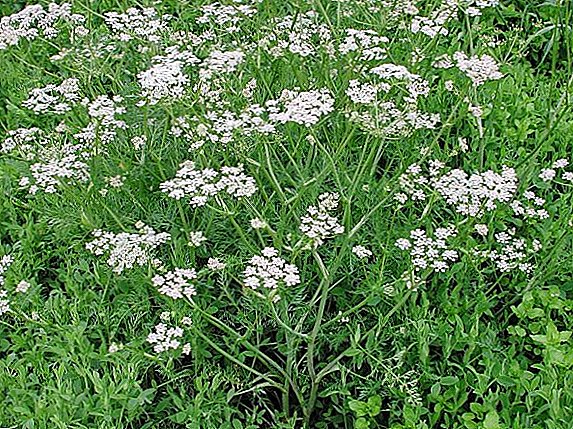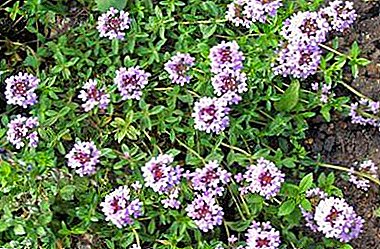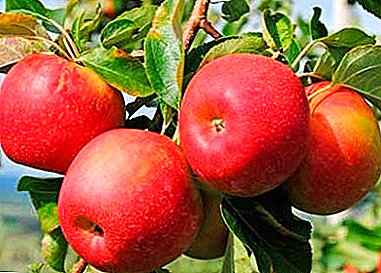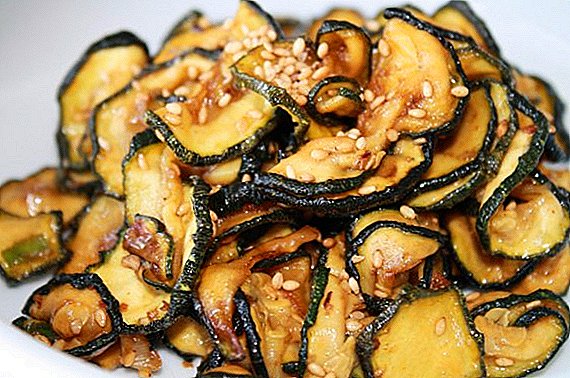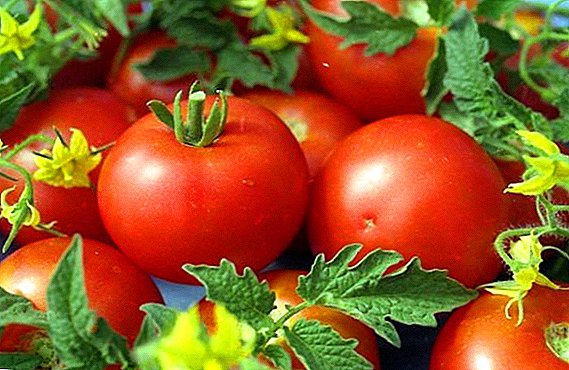 The phrase "White filling" most people associate with the name of apples, and only experienced gardeners know that this is also an ultra early variety of tomatoes.
The phrase "White filling" most people associate with the name of apples, and only experienced gardeners know that this is also an ultra early variety of tomatoes.
And although it does not stand out as particularly exotic, the White Beer tomato has a number of characteristics that deserve attention.
History of tomato selection "White filling"
The variety of tomato "White filling" was bred in Kazakhstan in 1979 and is the result of the painstaking work of plant breeders at an experimental vegetable station under the direction of Professor Edelstein.  The name of the famous variety of apples he received for the color of the fruit when ripe - it changes from green to creamy milk, like an apple.
The name of the famous variety of apples he received for the color of the fruit when ripe - it changes from green to creamy milk, like an apple.
Did you know? Today, breeders know 10 thousand varieties of tomatoes. The mass of the largest vegetable was 2.9 kg, and it was grown in America.
"White filling": characteristics of tomatoes
When choosing a variety of tomatoes for their plot, gardeners are primarily focused on the description of the plant and its yield.
Description of the bush
Bushes of this variety grow low and compact. Under greenhouse conditions, they can be up to 0.7 m high, and do not grow above 0.5 m in open ground. The stem of the plant is strong, and the roots are powerful and can grow up to 50 cm in diameter. The leaves are medium in size, light green, smooth.
Description of the fetus
Ripe fruits of tomato "White filling" can be given a description: bright red, round, smooth, with thin skin, fleshy and juicy. The average weight is 90-110 g. They withstand transportation and storage, are resistant to cracking. Tomatoes of this variety ripen almost simultaneously, literally in two weeks. 
Yield
Today, in terms of its yield, this variety belongs to the varieties with an average index, although at the time of hatching it was believed that the “White Beer” tomato had a high yield. With one bush you can get up to 3 kg of tasty, juicy fruits.
Did you know? Until the end of the XVIII century, the fruits of tomatoes were considered poisonous, and their bushes were grown only as an ornamental plant.
Application
The described variety is grown mainly for harvesting for the winter, as when canning tomatoes do not crack and keep their shape well. Juice is also made from them - it turns out to be saturated red and thick. The variety has proven itself in the manufacture of ketchup, adjika, tomato paste, as well as when frozen. Use tomatoes of this variety and in fresh form for salads, omelets, hot dishes and vegetable cuts.
If you want to treat yourself to something unusual, try making tomato jam.
Pros and cons varieties
Like any other, the variety of tomato "White filling" received both positive and negative reviews of gardeners and farmers. Thanks to them, such advantages of growing this plant:
- super early maturation;
- does not require a garter and pinching;
- ripening uniformity;
- resistance to cold;
- It is not exacting in leaving and to weather conditions.

Sowing seeds of tomatoes "White filling" on seedlings
Before sowing tomato seeds, you need to figure out how to prepare them for this and when it is better to sow, as well as choose a good soil and suitable containers.
Optimum time for sowing
As a rule, in order to get their own seedlings of tomato “White filling” for the greenhouse, sowing of seeds is carried out in the third decade of March - the first decade of April. If planting is planned in open ground, then mid-April will do, since the seeds germinate quickly and in one and a half months they will be ready for planting.
Soil and capacity for growing seedlings
For growing your own seedlings in the apartment ground better to use the purchasewhich is already completely ready for use. You can bring the land from the site, mixing it with peat and sand, as tomatoes prefer loose, light soil. It is also useful to process it with boiling water the day before sowing.
You can sow in special containers, plastic containers or in any container unnecessary in the household. Be sure to do at the bottom of the hole for the release of excess water. In the future, seedlings dive, so you need to immediately stock up on plastic, paper or peat cups. It is very convenient to sow in peat tablets - plants can not dive, and planted in the ground with a tablet.  You can sow seeds right on the site. For this, it is not necessary to build a greenhouse. From boards with a height of about 50 cm they knock a square or a rectangle, place it on a previously prepared ground and fix it well - on the outside they make something like a land shaft.
You can sow seeds right on the site. For this, it is not necessary to build a greenhouse. From boards with a height of about 50 cm they knock a square or a rectangle, place it on a previously prepared ground and fix it well - on the outside they make something like a land shaft.
The earth steamed with boiling water, allow to cool slightly and sow seeds. Sowing on top is covered with glass and insulated with old jackets, fur coats, etc. In this warm house, spring frosts are not terrible for seeds. When shoots appear, in warm weather, you can remove the shelter for the day, leaving only the glass. But in the evening, be sure to wrap up again.
Learn how to grow tomatoes without using soil.
Seed preparation for sowing
Standard training is soaking seeds in a pink solution of potassium permanganate for about half an hour. Then the seeds are washed in pure water and, if desired, soaked in a growth promoter. You can buy it, and even better to dissolve a teaspoon of honey in a glass of water - you get a great natural stimulant. Then the seeds are laid out on paper or newspaper and dried. Now they are ready to go to the ground. 
Sowing seeds for seedlings
Prepared seeds lay in the ground at a distance of about 2 cm from each other. It is convenient to carry out sowing with a special hand drill or you can use a toothpick, pre-wetting it in water to pick up the seed. Between the rows retreat by 4 cm.
Sprinkle the crops on top of a loose soil with a layer of no more than 2 cm and gently pour out of the syringe or sprinkle with a spray bottle. Then everything is covered with glass or film so that moisture does not evaporate.
Conditions and care for crops
Optimum temperature for seed germination - +23 ° Ctherefore, it is necessary to prevent a decrease in the temperature in the room, and also make sure that the soil remains wet.
After the sprouts appear, the container is opened and continues to monitor the soil moisture. It is important to prevent water from entering the leaves. Dive is carried out in the presence of two full leaves.
Care for tomato seedlings
Caring for seedlings of this variety does not cause much trouble, and its independent cultivation provides a guarantee of obtaining this particular variety.
Lighting
Young plants need enough light, but they must be protected from direct sunlight.
You can set the capacity on the windowsill in the room where the sun shines early in the morning or only in the evening. Or you can create a penumbra covering the blinds, as well as with the help of newspapers and pieces of wallpaper. In the evening, a desk lamp or a fluorescent lamp is suitable for additional lighting.
Watering
It is necessary to water already dived plants as the soil dries. This is usually three times a week and always at the root. There should be holes in the cups so that the water does not stagnate, since excess moisture causes black leg disease. 
Top dressing
The first feeding with a special complex fertilizer is carried out not earlier than later. ten days after diving. Fertilizer should be just for seedlings, as babies can not "digest" adult food. Then - one more feeding two weeks later, and the last - two weeks before the intended landing.
Hardening
Hardening seedlings can begin immediately after germination - take out to the balcony three days in a row at +15 ° C and leave for 30 minutes, then at +10 ° C. Although most gardeners do it 14 days before planting in open ground. In the evening, pallets and cups shall be carried out to the balcony or to the street, first for one hour, then for two, etc.
After a week, you can make it in the morning and leave it all day, just not in the sun. They also train them to direct sunlight gradually - they start from 30 minutes in partial shade, and every day the duration of sunbathing is increased.
Transplanting tomato seedlings to a permanent place
When the tomatoes grow at least 20 cm tall and get strong enough, it is time to define them for a permanent place. 
Optimum time for disembarkation
The timing of landing depends on the characteristics of the local climate and the likelihood of night frosts. This is usually the last decade of May - the first half of June. In the greenhouse planted ten days earlier. If the planting is carried out in May, then it is possible to land in stages, so that in case of frosts the whole crop is not lost.
Important! Even if the seedlings are hardened - it will not guarantee that it will survive frost. If the plantation is already planted, and weather forecasters promise frosts, you can expand or stick tree branches around the bushes that will take on the "main blow".
Selecting a landing site: lighting and soil
Tomatoes prefer a slightly acidic, light and moderately nutritious soil. As a rule, it is loamy or sandy soil. Land is prepared in the fall, making fertilizer or compost, and at high acidity - lime. The more sun the tomatoes get, the less they are exposed to fungal diseases and mature better. Therefore, the landing is carried out on the south or southeast side of the site.
Good and bad predecessors
It is better to give the tomatoes the area where they used to grow cucumbers, onions, cabbage or zucchini. After crops such as potatoes, sweet peppers and eggplants, tomatoes can be grown no earlier than three years later, since these plants are prone to the same diseases.
The optimal scheme for planting seedlings
Planting tomatoes do not like cramping, so the bushes need to be located in staggered order no closer than 50 cm from each other and the same to leave between the rows. If you save space and place them too close - it will negatively affect the ripening of the fruit, and in case of illness, the plants will become faster infected.
Tips for the care of tomatoes "White filling"
It’s easy to get a rich harvest of tomatoes “White filling”, as they are undemanding to care, but you still need to follow certain rules of their cultivation.
Watering, weeding and loosening the soil
Tomatoes dont need in frequent watering. It is enough to do this twice a week, but abundantly and at the root. For this procedure, choose the morning hours, before sunrise. In the evening, you can water only if the temperature does not drop below +20 ° C at night, otherwise there is a risk of fungal damage.  It is important to remove weeds and loosen the soil in time to give the roots enough oxygen. Also, before the fruit begins to ripen, the bushes roll up several times to form lateral roots.
It is important to remove weeds and loosen the soil in time to give the roots enough oxygen. Also, before the fruit begins to ripen, the bushes roll up several times to form lateral roots.
We recommend that you familiarize yourself with the features of mulching tomatoes in the greenhouse and in the open field.
Top dressing of tomatoes
You can feed both organic and inorganic fertilizers. The first feeding is carried out 14 days after disembarkation, the next two in the period of formation of the ovary with a time interval of two weeks.
As a top dressing, a mullein infusion is suitable with the addition of superphosphate: 9 parts of water and 20 g of mineral fertilizer are taken for 1 part of manure. Under each plant poured 1 liter of the mixture.
Important! Before dressing the bushes need to be watered - nutrients will get faster through the moist soil to the destination.
Also as supplements fit such infusions:
- yeast;
- wood ash;
- a weak solution of chicken droppings;
- nettle infusion;
- decoction of onion peel.
Forming bushes
Since the tomato variety described is undersized, it does not need pinching or pinching. This can be done with time and desire, but not mandatory. To increase the yield, you can leave 2-3 brushes, and cut off the rest. In this case, the fruits will be larger, and the bushes will have to tie up. 
Preventive measures against pests and diseases
Prevention of pests and diseases right to do in the fall.
First, remove all weeds. Then the site must be dug up with the addition of ash, which is both fertilizer and an excellent disinfectant, and only then treat the land with special pest remedies. Indeed, in the cold time, the larvae hid in the soil, and thus you will destroy most of them.
A good prevention is the treatment of seedlings 20 days before planting - this can be a 0.5% solution of Bordeaux mixture or copper sulphate. When planting in each well is useful to add all the same ash and a handful of onion peel.
You can protect yourself from pests by planting tomatoes away from the potatoes and planting nasturtium or marigolds with them, the smell of which frightens many uninvited guests.
Tomatoes grown in their plot are definitely tastier and healthier than purchased ones, and if you follow the guidelines for planting and care, they will surely please you with a rich harvest. And the White Beer, proven over the years, deserves to take a place on your garden bed.


